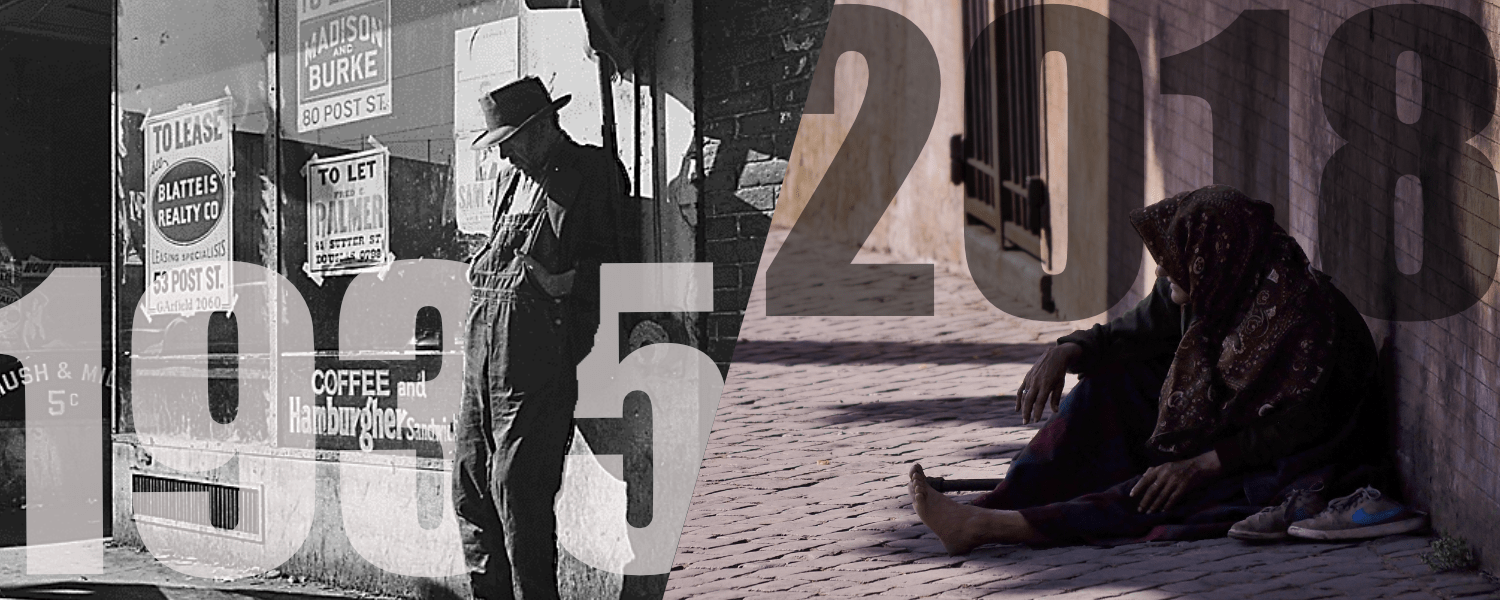The summer before I entered the Jesuits was a magical one, full of sunsets, road trips, awesome Western thunderstorms, bison, and a cave. I was an interpretive ranger at Wind Cave National Park in South Dakota. In the southwest corner of the Black Hills, the cave is one of the longest in the world and the plains above are home to one of the few herds of purebred bison.
All of these opportunities stemmed from my internship through the Student Conservation Association, a program initially founded to model the Civilian Conservation Corps (CCC) and develop future conservation leaders. The long term impact of the CCC and other New Deal programs is evident today. From buildings constructed, to the recording and collection of personal stories, to planting forests, New Deal programs helped shape our nation and communitarian values. As I look at crumbling infrastructure, parks in need, and the number of Americans that go unheard, I am unequivocally convinced: America needs a new New Deal.
****
Our Great Depression
Our current economic data hides many flaws. It can be easy to point to the number of jobs created, the rate of unemployment, and the GDP as figures of economic strength. Whereas the Great Depression featured a jump in unemployment to 20%, we presently sit at a measly 4.1%. Examining this data alone might point to a lack of US economic hardship. But while the unemployment rate is low, other factors such as underemployment, poverty, infant mortality, and the wealth gap say otherwise. For many Americans, we are living our own Great Depression.
The wealth gap in the US is almost as high as 1929, which you may remember as the year the stock market crashed to usher in the Great Depression. While this is a relational rather than causational fact, the wealth gap nevertheless points to a tragic maldistribution. This wealth gap is even worse when examined through a racial lens. According to the Institute for Policy Studies, the wealthiest 100 households now own about as much wealth as the entire African American population in the United States. Among the Forbes 400, just 2 individuals are African American – Oprah Winfrey and Robert Smith. Moreover, the wealthiest 186 members of the Forbes 400 own as much wealth as the entire Latino population. Just five members of the Forbes 400 are Latino including Jorge Perez, Arturo Moreno, and three members of the Santo Domingo family
In addition to this great inequality, other statistics demonstrate the undercurrents of America’s bleaker economic reality. Over 20 percent of America’s children live below federal poverty standards. Even more accurate measurements that account for the needs of families place childhood poverty at a staggering 40 percent.
Another key indicator of population well-being is the infant mortality rate. Of the 20 wealthiest countries in the world, the US has the worst infant mortality rate at 6.1 deaths per 1,000 live births. It again gets worse when examining it by race. In 2014, the Center for Disease Control reported that white children have an infant mortality rate of 4.9 deaths per 1,000 live births; black children, in comparison, have more than double that with 10.7 deaths per 1,000 live births.
America is haunted by entrenched poverty, one which it created and sustains. This deep poverty lurks across major cities, the Mississippi Delta, Appalachia, America’s farmlands, and more. While we can point to the Great Depression as a massive fall for America, the preceding Roaring Twenties had their own deeply embedded poverty that often ran unnoticed until the Depression. To truly break these long-standing cycles, America needs to recreate programs for the good of communities so often forgotten.
A New New Deal
The number and variety of New Deal programs is a bit staggering, ranging from the creation of the US Travel Bureau to the National Housing Act. These efforts sought to reduce poverty and inequality while bolstering the health of the nation. Three programs from the original New Deal stand out as having incredible potential to attack the issues at the heart of our current Great Depression: the Federal Surplus Commodities Corporation (FSCC); the Glass-Steagall Banking Act; and Social Security expanded into a national healthcare system.
The FSCC began as a way to simultaneously bolster food prices and provide food to families in need. The program connected and funded food from over-stocked farmers to impoverished communities. In 2016, over 40 million Americans (including 13 million children) were food insecure, meaning that they were unable to afford nutritious and sufficient amounts of food. Meanwhile, America threw out enough food in 2012 for every American to have 1,200 additional calories in their daily diet. Recreating the FSCC could drastically increase the stability of smaller and family farms and ensure that low-income Americans have enough healthy food to eat.
Passed in 1933, the Glass-Steagall Act created a buffer between investment banking (i.e. the stock market) and commercial banking (i.e. everyday deposits & loans). The act helped reduce bank closures from 10,000 at the start of the Great Depression to fewer than 600 from WWII into the 1980s. It also led to the creation of the FDIC. While the Glass-Steagall Act would not directly supply food or other immediate relief, it would decrease inequality and create greater protections for consumers.
Lastly, the United States needs a national healthcare system. Social security initially included a program to provide a baseline of healthcare to all Americans, but pushed it aside to assure passage of the rest of the Social Security Act. Guaranteeing access to healthcare would reduce costs, expand Title V and maternal health, and tackle issues like the boom of poverty-related illnesses like dengue and Chagas disease.
Protecting Public Lands
The original New Deal also had an incredible impact on America’s public lands through the establishment of the Civilian Conservation Corps (CCC), Works Progress Administration (WPA), and even the Tennessee Valley Authority (TVA). These projects largely started as a way to employ millions of jobless young men, as well as preserve a rapidly degrading land.
The continuing impact is tremendous. From 1933 to 1942, the CCC planted over 3 billion trees, erected over 3,400 fire watch towers, created drainages on millions of acres of land, and helped to restore wild rivers and habitats. They worked to preserve the land, as well as make it more accessible, improving over 800 parks nationwide.
While the CCC frequently worked on land-focused projects, the WPA created the infrastructure to enjoy these incredible places. The list of WPA accomplishments is somewhat absurd, including but not limited to: 40,000 new buildings, 85,000 improved buildings, 1,600 parks, 1,000 libraries, hundreds of lodges, and thousands more spaces for recreation. The lasting impact on America’s public spaces is difficult to quantify. Unfortunately, Congress shuttered both the CCC and WPA with the onset of World War II. We need a new New Deal to renew our commitment to protecting our parks and public spaces.
Recovering our History
The original New Deal also recognized the value of the stories that accompany the lives of American people. For example, the Federal Writers Project collected the stories of hundreds of former slaves. This incredible project realized the importance of people so often forgotten. The value of these stories is hard to articulate. While historians at that time tended to focus on great figures and incredible deeds, the WPA shifted the focus to the stories of those unnoticed.
We need to recapture our history. I wonder what would be the result if we took on a similar project today. In my mind, several groups stand out who have stories and lessons that are worth retelling: those who survived the Great Depression, those who participated in civil rights efforts, veterans of 20th century wars, itinerant laborers, and the people of Appalachia. Each of these groups includes people so often embattled by stereotypes, those who regularly read stories of themselves full of falsehoods and half-truths. America would benefit immensely from people having the opportunity to tell their stories, what happened in their lives, and more. Our empathy, cura personalis, and commitment to justice would drastically increase if we would drastically increase if we re-started the Federal Writers Project in an effort to recapture our history once again.
Communitarian Values
Each of these – economic justice, protecting public lands, and recapturing our history – were essential components of the New Deal. Our current economic and social climate points to the need for a new New Deal.
At the root of it all, I believe that America has lost its tradition and memory of communitarian values. In examining our past, we must realize that we were strongest when we took care of whole communities, recognizing our dependence on communities and their dependence on us.
America’s national childhood (1715 to 1789) took place during a boom of individualism. We grew from philosophies that emphasized our personal liberties and freedoms, and pulling oneself up by their bootstraps. Despite this grand philosophy, it has hardly ever been our reality. Even while espousing the value of individual hard work, communities bonded to support each other. While our national rhetoric depends on John Wayne-style cowboys who go it alone, our truest identity depends on the stories from the whole community.
I believe that deep down, America truly needs to rediscover itself as a community. It must meet its own neighbors, share their stories, and share in their work. A new New Deal can create programs which can make that happen. We must be willing to offer of ourselves for the betterment of our community and country.


